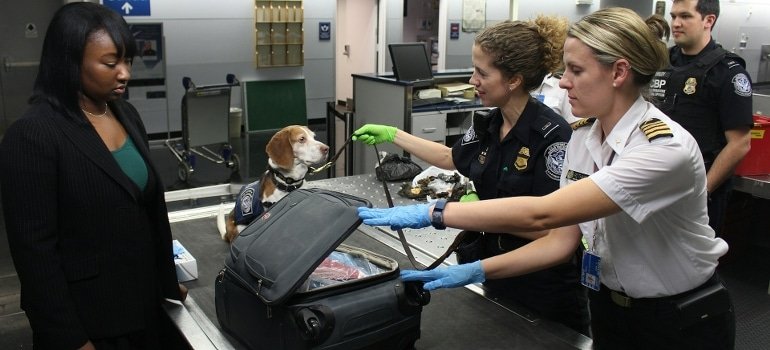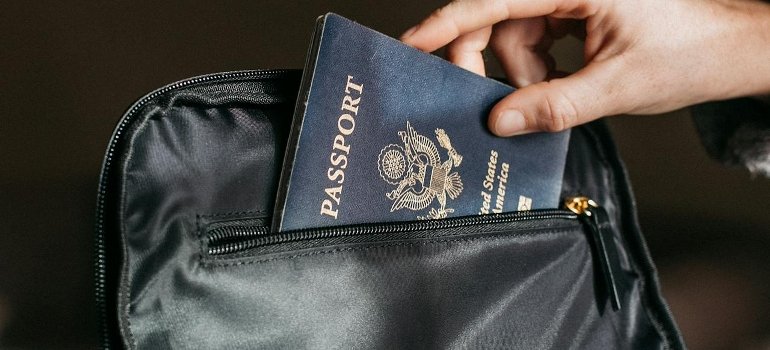How to Pack for an Overseas Move?

Get a Free Moving Quote Now!
Start Your International Moving Journey





Packing for a move abroad comes with its own set of challenges. When you pack for an overseas move, every detail matters—size, weight, durability, and compliance with customs rules. Long shipping times and multiple transfers mean your belongings must be well-protected from start to finish. International movers can help by recommending materials, packing techniques, and documentation that meet destination requirements. They also know how to handle items that need extra care, from electronics to heirlooms. Starting early gives you time to organize, label, and prioritize what truly needs to make the trip. The right preparation reduces the risk of delays, unexpected costs, and damage, allowing you to focus on settling into your new home with confidence instead of dealing with preventable problems.
Consider the Customs Regulations
To execute an international move successfully, international movers in NYC recommend that you conduct some additional research and do a lot of preparation ahead of time.

Ask ChatGPT
- Check the official customs website for your destination to review prohibited and restricted items.
- Identify items requiring permits or documentation, such as certain electronics, alcohol, medications, plants, and animal products.
- Verify quantity limits on goods like tobacco, food, or alcohol to avoid penalties.
- Prepare a detailed inventory listing each item, its description, and value for customs clearance.
- Match your inventory against the destination’s customs requirements before sealing boxes.
- Gather required documents, such as proof of purchase, import licenses, or fumigation certificates.
- Label boxes clearly for easy inspection at customs.
- Hire an experienced international shipping company to manage transport and paperwork.
- Use a licensed customs broker to handle clearance, inspections, and communication with authorities.
Declutter Your Possessions
Some of the best international movers in NJ say you can save significantly on costs by reducing what you take. Before you pack for an overseas move, follow this checklist:
- Go room by room and review every item you own.
- Create three categories: ship, sell, donate.
- Prioritize essentials you will use immediately in your new home.
- Sell valuable but nonessential items to offset shipping expenses.
- Donate usable goods to lighten your shipment and help others.
- Check customs regulations to identify items that are prohibited or heavily taxed.
- Factor in shipping costs for bulky or heavy items before deciding to send them.
- Avoid shipping duplicates or items you can easily replace abroad.
- Reassess sentimental items—decide if they are worth the cost of transport.
- Confirm your final list with your moving company to estimate shipping weight and fees.
Create Your Inventory
A detailed inventory is essential for smooth customs clearance when working with international household goods movers. Before your shipment leaves, make sure you:
- List every item you plan to ship, from large furniture to small personal belongings.
- Provide clear descriptions for each item, including brand, model, and material when relevant.
- Assign accurate values for insurance and customs declarations.
- Number boxes and link them to your inventory for easy reference.
- Photograph valuable or fragile items to record their condition before shipping.
- Highlight special handling requirements for breakable, oversized, or hazardous goods.
- Identify restricted or high-duty items to confirm compliance with destination rules.
- Store a digital copy of your inventory to prevent loss of records.
- Share the completed list with your movers and customs broker.
- Update details if you add or remove items before finalizing the shipment.
Gather Good-Quality Packing Supplies
Using professional packing services for overseas shipping can save time, but if you’re preparing items yourself, quality materials are non-negotiable. The right supplies protect your belongings during long transit times, multiple handlings, and varying climate conditions. Here’s what you need to pack for an overseas move efficiently:
- Strong moving boxes in various sizes for different types of items.
- Corrugated boxes that fully close and offer extra strength for heavy or delicate goods.
- Packing paper or bubble wrap to cushion fragile items and prevent movement inside boxes.
- High-quality packing tape to seal boxes securely and withstand international handling.
- Permanent markers and labels to clearly identify contents and destination rooms.
- Blank newsprint, bubble wrap, or plastic wrap to fill empty spaces and prevent shifting during transit.
Tips for Packing Kitchenware
To keep kitchen items safe during an overseas move, international movers in Chicago recommend:
- Pack any ceramic kitchenware and fragile bone china items in bubble wrap.
- Use extra packaging for wrapping sharp cutlery and glass containers.
- Place packing paper in between any bowls, plates, or cups you will need to be packed as this will prevent these items from breaking and chipping.
- Double-wrap your crystal pieces, vases, or wine glasses in packing paper and bubble wrap.
- Pack the utensils and cutlery together in compact bundles and bubble wrap them before putting them inside the moving boxes.

Tips to pack electronics
To prevent damage during transit, international movers in San Francisco suggest:
- Unplug all the electronic devices before you pack them.
- Unplug the refrigerator at least 24 hours before loading them as any excess water or ice will be drained from the appliance.
- Tape the table inside a microwave oven, otherwise, it may move during transit and damage the glass door.
- Read the manual of any electronic appliances to check if any special instructions are provided or not.
- Use glass screens to double-pack electronics and make sure they don’t break.
Tips to Pack Small Furniture
To keep small furniture safe during transit, international movers in Los Angeles recommend:
- Fully cover all edges with protective padding to prevent chips and dents.
- Wrap surfaces in blankets or bedsheets to shield against scratches.
- Secure corners with foam or cardboard protectors for added impact resistance.
- Disassemble pieces when possible to make packing easier and reduce damage risk.
- Use plastic wrap or moving blankets to keep drawers and doors closed during transport.
- Double stack carefully in the moving truck or container with padding between items to protect surfaces.
- Avoid placing heavy objects directly on delicate pieces to prevent crushing or warping.
- Label fragile or high-value furniture for careful handling.
Tips to Pack Other Miscellaneous Items
To pack for an overseas move, international movers in Houston suggest:
- Use sturdy corrugated boxes for books and avoid overpacking large boxes; place heavy books in several smaller boxes.
- Pack clothes and shoes in durable, international-sized moving bags to save space.
- Request wardrobe boxes with hangers from your movers to keep clothing wrinkle-free during transit.
- Insert packing paper between photo frames to prevent scratches and glass breakage.
- Consult your moving service provider for specialized packing methods for pianos, fine art, and musical instruments.
- Use custom crates or protective cases for delicate or high-value items.
- Clearly label all boxes with contents and handling instructions.
- Fill any gaps in boxes with soft packing material to prevent shifting.
Choose Between Sea Freight and Air Freight
When deciding on a shipping method, international movers in Denver recommend considering the following:
- Transit time: Air freight typically arrives within a few weeks, while sea freight can take several months.
- Cost differences: Air freight is faster but significantly more expensive than sea freight.
- Type of items: Use air freight for essentials like cookware, bedding, and clothing that you’ll need right away.
- Bulk shipments: Ship larger items such as furniture, appliances, and bulk goods via sea freight to save money.
- Combination approach: Split your shipment—send urgent items by air and non-urgent items by sea.
- Customs processing times: Factor in that air shipments often clear customs faster than sea shipments.
- Weight and size limits: Air freight has stricter size and weight restrictions compared to sea freight.
Pack Your Valuables Separately
When you want to pack for an overseas move, keep in mind that you must take some of your valuable possessions on the plane.
- Important papers like marriage certificates, birth certificates, school records, medical records, and insurance policies.
- Heirlooms, jewelry, and other valuable items.
- Phone, laptop, camera, chargers, and mp3 players.
- Medicines
- Cash, credit cards, wallet, and checkbook.
- Passport, visa, and other vital papers.

List of items in your luggage
- Suitable clothing according to the weather and shoes you will need after reaching the new house. It will take time for the shipment to reach your new destination, so it’s better to plan things in advance.
- Toys and other essentials for your kids.
- School essentials, backpacks, and books.
- Air bed
Buy Moving Insurance
When relocating overseas, your shipment will likely pass through several handling points, ports, and customs inspections, increasing the risk of loss or damage. Data from the World Shipping Council shows that an average of 1,382 containers are lost at sea each year, and transit damage claims account for roughly 20% of all international moving disputes. Without adequate insurance, carriers are typically liable for as little as $0.60 per pound under standard terms, which means a $1,000 laptop weighing 5 pounds might only yield a $3 payout if damaged.
Full-value protection or comprehensive moving insurance can reimburse the actual replacement or repair cost of each item, whether due to rough seas, mishandling, theft, or water intrusion. Premiums usually range from 1% to 5% of the shipment’s declared value, so insuring $50,000 worth of goods could cost $500 to $2,500. Coverage can be purchased through your mover or a third-party provider, but policies should clearly outline exclusions, claim deadlines, and documentation requirements to avoid disputes.

Tips: In the case of high-value items like antiques or artwork, it’s recommended to get them appraised beforehand and determine their real value.
Key Steps to Pack for an Overseas Move
Before your shipment leaves, double-check every step to avoid costly mistakes. When you pack for an overseas move, confirm that all items match your inventory list and comply with the destination country’s customs regulations. Use sturdy boxes, quality packing materials, and clear labels to keep handling smooth during transit. Separate essential items and send them via faster shipping if needed, while bulk goods can go by sea to save money. Review insurance coverage so the declared value accurately reflects your belongings. Communicate with your moving company about any fragile, oversized, or restricted items, and keep copies of all documents in both physical and digital formats. A final inspection before loading ensures nothing is overlooked and reduces the risk of delays, fines, or damage when your belongings arrive at the new destination.
